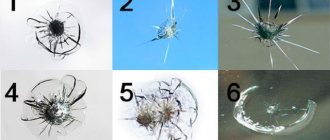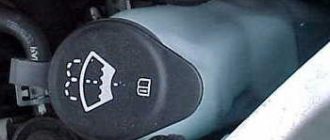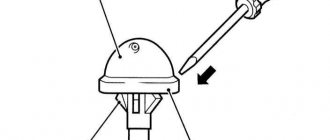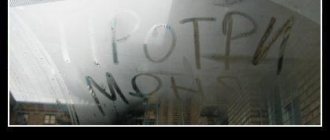All car enthusiasts are familiar with windshield washer systems. This is such a simple and convenient system that it seems incredible that not so long ago not all cars were equipped with them. But this is true, and if we go deeper into history, a rear-view mirror was first installed on a car in 1911, and exterior mirrors began to be massively equipped on cars in the Soviet Union only in the 1950s. So, modern glass washers suffer from several “diseases” that competent car enthusiasts should know about. Let's look at the design of washers and look at their main faults.
A brief excursion into history
Window washers first appeared in cars around the second half of the 20th century. In the Soviet Union, the first cars produced by Gorky Automobile were equipped with such a device. Although domestic transport differed in many ways from foreign transport of that time, glass washers in old cars were almost the same . The main thing here is that at first they were mechanical . The driver pumped water to wash the windshield using a special handle on the front panel in the cabin. The drive remained manual for a long time, only the lever on the panel was replaced by a small pedal that had to be pressed with the left foot.
Spare parts for zaz vida
High voltage wires, set
1.4 F14D3
Spare parts for Renault 20
Steering rack/mechanism oil seal (see standard sizes) 1.6 (1271) 843 720
After some time, the mechanical pump was replaced by an electric one. It was more convenient and practical. Firstly, there was no need for a manual drive. Secondly, the electric washer could be used together with the windshield wiper blades. The washer nozzle, otherwise called the jet, has also changed. Now it was installed on a strip under the windshield or directly on the hood. A more powerful nozzle supplied water or a special liquid to a larger part of the windshield (previously only the driver's side was washed). Experiments with installing nozzles directly on brush leads have been carried out, but nowadays the results can only be seen on buses or trucks.
Design and features of washers
The washer mechanism is quite simple. Its key parameter is reliability and durability. Over their long history, washers have been redesigned many times, and some solutions that were conceptual at the time are quite commonplace today. Here are the elements that a windshield washer includes:
- Tank with a volume of 2.5-5.0 liters;
- Electric pump;
- Feed tubes;
- Injectors.
As mentioned above, the volume of the tank is quite large - from 2.5 to 5.0 liters . The volume largely depends on the car model. The tank is usually located under the hood of the car. An electric pump is built into the tank, which is responsible for the normal supply of liquid. Tubes are connected to the pump, which then go to the injectors. Most cars use jet type injectors. They deliver liquid in the form of a jet, which hits approximately the middle of the windshield. Less common fan nozzles spray liquid in a kind of cone above themselves, covering a large area of the glass. It is worth noting that cars operating in cold climates are often equipped with heated injectors - in severe frosts even the so-called. Anti-freeze containing ethyl, isopropyl alcohol or even ethylene glycol can actually freeze in the tank.
Special mention should be made of the windshield wiper check valve . The fact is that the cleaners of many cars are simply not equipped with it. However, even this design will work. The valve performs only one function - to prevent washer fluid from flowing back into the tank if the pump is turned off. In fact, this is the most ordinary spring-loaded ball that closes the nozzle hole when there is no liquid pressure on it.
Technical characteristics of the gearmotor:
The purifier has three operating modes, they are activated by the right steering column switch. Intermittent mode is provided by an electronic relay type 52.3747 or 525.3747 installed in the mounting block. The relay also turns on the low speed wiper motor when the windshield washer is turned on. The relay must ensure that the electric motor is turned on with a frequency of 14±4 cycles per minute at a gearmotor shaft speed of at least 20 min–1, a temperature of (20±5) °C and a supply voltage of 14±0.2 V.
When the cleaner operates at low speed in constant mode, the supply voltage is supplied to diametrically opposed brushes. When the cleaner operates at maximum speed, “+” power is supplied to the brush located on the side.
The windshield washer consists of a polyethylene reservoir with an electric pump installed on the right side of the engine compartment, washer nozzles located on the hood, and flexible connecting hoses.
The washer is activated by the right steering column switch, and power is supplied to the pump motor and windshield wiper relay, which turns the wiper on at low speed if it has been turned off or was running intermittently. If the pump malfunctions, it is replaced. Clogged nozzles can be blown in the opposite direction or cleaned with fishing line.
The washer solenoid valve in a vertical position (with the fittings down) should operate at a voltage of no more than 8.5 V. The resistance of its winding at 25 °C should be (95 ± 6) Ohms.
The windshield washer has a special pump that is responsible for pumping water to the mechanism. The pump is externally represented by a small part, which is extremely important for the operation of the entire system. Due to the significant load, the device wears out quickly. Despite the fact that the pump looks like a part of a toy car, failure of this chain link can be a big problem for the driver, especially in rain or snow.
Design and principle of operation of the windshield washer
The washer is an important part of the car as a system. It can be used to keep things clean. You can use this device in absolutely any weather, and the use will be justified. This fact is due to the fact that when it rains, the window becomes covered with dirt due to the active movement of cars in the next row, in winter slush and snow are added to the dirt, and in summer, during fast driving, a large number of insects stick to the windshield.
Key elements of a washer of any type and manufacturer
- this is a pump, a tank and a pump that supplies water to the glass for cleaning
.
The nozzles must be mounted so that the stream of water hits directly the middle of the windshield. A pump is needed to supply water to the tank. It makes sense to point out that some car models provide water supply not only to the windshield, but also to the headlights and rear window. A pump is a small-sized motor that consists of an impeller, brushes and an oil seal. The brushes are the wipers. Sediments of all car models are different in structure and appearance. But the mechanisms of different brands of cars work on the same principle: the sediment forcibly supplies water or a special liquid for washing windows.
If the washer stops working in the car, then there is a high probability of a breakdown of the nozzle or reservoir. Based on the characteristics of the car model, these elements can either be repaired or completely replaced. But if the washer pump breaks down, then the driver will probably be confused due to the breakdown of a part that is often deprived of attention.
Windshield washer pump - breakdowns and their causes
If fluid stops flowing into the washer, this is a sure sign that the pump is broken.
If a breakdown is discovered, then you need to proceed to repair work as soon as possible, since the cleanliness of the car windows affects the comfort and safety of movement. But the washer does not always stop working because of the pump. More frequent situations occur when the washer does not function due to the following:
1)
The jets or the filter itself are clogged. To restore and improve operation, you need to thoroughly rinse all elements of the system that you must first dismantle. Sometimes it may be necessary to bleed the washer system;
2)
The hoses through which water is supplied have lost their tightness. In order to get rid of this breakdown, worn elements will need to be replaced with new ones;
3)
The parts were not connected correctly;
4)
The shafts of the electric motor and the pump are loosely connected. To restore operation, you just need to fasten the part;
5)
The motor itself broke down. Before replacing a part, make attempts to clean all elements and brushes, try removing corrosive elements with an ordinary eraser.
How to replace the washer pump?
If the pump in the washer system breaks down, it is advisable to immediately replace it with a new device. In principle, for any car model you can find an alternative version of the pump model that will fit the tank like a glove. A very large number of car owners may wonder how to replace the washer pump? Such work will be quite simple and will not take much time. You may laugh, but all you need to do is take a screwdriver to install the new part.
To check the pump, you need to turn it on, but only for a couple of seconds. If it works longer, then there is a high probability that it will simply burn out, because it works in water and not in air.
First you need to find the tank in the car; it is better to look at its location in the manual for using the machine. Sometimes it can be noticed immediately after you open the hood, but in some car models, in order to find the reservoir, you will even have to dismantle the inner fender protection in order to get to the container. The sequence of actions when performing such work is as follows. First you need to disconnect the wire from the “-” terminal of the battery, after which you will need to disconnect both wire blocks from the pump engine. After this you can remove the tank.
After this, you will need to separate the fitting and the hose, and then you need to drain the liquid. You will need to use a screwdriver to push the intake out of the seal sleeve. After you have completed all the steps, you can remove the pump from the tank. It will be necessary to install a new bushing, since it is precisely because of this that the pump most often breaks down. After replacement, you will need to perform all the steps, only in reverse order, in order to return the washer system to its original state.
The cleanliness of the car, including the glass, will indicate what kind of driver is behind the wheel. Therefore, to create your own image in the eyes of other car owners, follow the system with which you will need to maintain the car windows in order.
A windshield washer is a part that is included in any car. Although the design of this device is simple, and the mechanism itself is very compact, its role in the process of driving a car cannot be diminished.
So that the windshield can not only be wiped with brushes, but also washed.
It is often used:
- in the rain. Since dirt from cars passing by without a water supply will simply be smeared by the wipers on the glass;
- in the heat, when the glass is covered with dust and insect carcasses. If the brush can still sweep away flies and mosquitoes without moisture, it will simply roll the dust into paths without increasing visibility.
How it works
Let's make sure that the system of the elements listed in the last section will work. Firstly, there must be washer fluid . Secondly, the pump must be connected to the on-board electrical network. Of course, the pump itself must be operational . Thirdly, the supply tubes and nozzle must be in proper condition - if they are clogged or not connected, the liquid will not be able to get onto the windshield . If the system is equipped with a visibility sensor, which automatically turns on the pump when the glass is heavily soiled, then this sensor must also be connected to the network.
Here's how it works: when turned on, the washer pump pumps fluid from the reservoir into the supply tubes, after which the fluid passes through the nozzle holes and hits the windshield. The pump design is quite simple and includes seals, an impeller and brushes. The characteristic sound that can be heard before and during liquid supply is associated precisely with the fact that the impeller has begun to spin. The windshield wiper blades will also begin to work in tandem with the washer. Of course, the electric pump will not work when the engine is turned off and without a battery.
If the washer does not work
The reasons for the failure of this device are varied. We will mention the most common ones here:
- The cause may be a blockage. To eliminate it, you will have to flush the entire system or even blow it out additionally.
- Leaky hoses. If the hoses are leaky, if there are cracks and holes on their surface, then water will not flow to the nozzles. In this case, you will have to replace the worn hoses.
- There is no energy coming. Check whether the shafts of the electric pump and electric motor are securely fastened.
- Motor corrosion. Corrosion can be dealt with using an eraser.
- Other damage to the motor. If there is other damage, the motor will probably have to be thrown away and replaced with a new one.
This is the basic information about. We will be glad if you share your opinion about this article in the comments.
Autumn. Early twilight. Narrow country highway. Since the morning, then dying down, then intensifying again, a nasty cold rain has been drizzling. There is dirt on the asphalt from fallen leaves and sand from the side of the road. Behind every passing car there is a long trail. The truck ahead is practically invisible; it can only be identified by its side lights. The wipers work constantly, but they are of little use; you have to periodically spray the glass with washer. But there is a big gap in the flow of oncoming cars - you can try to overtake. The speed increases, the truck is already nearby, the washer works almost continuously, and suddenly it suddenly stops. The glass is instantly covered with a dirty film, almost nothing is visible through it. What to do? Finish overtaking? To brake?..
You don't want anyone to be in this situation. And the reliability of a seemingly cheap device—the windshield washer pump—let us down. This is what our conversation will be about today.
We selected ten samples for the test. There are many of them on the market today, the asking price is 150-200 rubles. In response to our request to present the entire assortment, some sellers shrugged their shoulders in bewilderment - they say, what difference does it make, they are all made in one, well-known country. But we will not rush to conclusions; we will draw them after testing.
We present to you the participants of our test. Designation - 992.3730, catalog number - 2110-5208009.
All experimental samples are tested according to several parameters. Firstly, this is the so-called control point. At a certain back pressure in the system (0.14 MPa), the fluid flow through the pump must be at least 4.5 ml/s. In this case, at a pressure in the system up to 0.16 MPa, the current consumption should not exceed 3.5 A, and at a pressure above 0.16 MPa it should not exceed 4.5 A. The results of this part of the tests are summarized in Table 1. At the same time, The EKAR and STSAR-1 pumps were unable to reach the control point.
The maximum flow rate and maximum pressure were also measured.
Let’s say in advance that not a single pump reached the declared maximum pressure of 0.25 MPa (2.5 atmospheres).
Next, we will test for resistance to inclusions with the armature locked. During it, motor pumps with chambers filled with water are kept at an ambient temperature of minus 40 ºС for at least four hours in a non-operating state, after which 10 starts are carried out lasting 0.5...1.5 seconds each, with a pause of 1...3 seconds between starts, at a voltage of 12 V. This test simulates a situation where in winter the liquid in the tank freezes, and the driver, without knowing this, turns on the pump. Here “STSAR-2” refused to work, the reason was an interturn short circuit of the electric motor rotor. The operating parameters of the remaining pumps did not deteriorate.
A very important test is to check the functionality after working with the discharge line blocked. This happens when in winter there is liquid in the tank and the injectors are frozen. During the test, the motor pumps are turned on evenly - once every minute, with a duration of the on state of 2...5 seconds at a voltage of 12 V with the discharge line blocked. After three hours of exposure under normal conditions, the parameters are checked. All pumps passed this test.
And finally, the last test is for heat resistance. It is no secret that in the hot summer the temperature under the hood of a car reaches significant values. Therefore, we kept the motor pumps at a temperature of 100 ºC for three hours in a non-working state, and after holding them for twelve hours under normal conditions, we checked the parameters again. At the same time, the Kaluga pump refused to reach control parameters, and the EKAR pump developed a fluid leak from under the cover covering the impeller. There were no comments on the other pumps.
After testing, we disassembled each pump to evaluate the quality of the components and assembly as a whole.
SMZ
Serpukhov Mechanical Plant. Sold in original packaging, the motor bears the manufacturer's marking - ZhenQi (most likely made in China), the shaft seal is of good quality, the electric motor contacts are on clamps, the housing is non-separable, the housing has drainage holes to remove moisture. The operating parameters are among the best. We recommend.
Manufactured by Stopol Group. Sold in packaging, electric motor contacts are on clamps, the design of the stuffing box seal is poor, the housing is dismountable. The operating parameters are good, but there may be problems with reliability. We don't recommend it.
STSAR-1
Saratov. We were sold two pumps of this brand, and, as it turned out, they are completely different in manufacture. Both were sold without packaging. In this sample, the electric motor is most likely made in China; our experts assessed the quality of the contact solder connection as low. The body is of a collapsible design. Taking into account the poor quality of the seal and the failure when checking the parameters, we do not recommend it.
STSAR-2
But this sample is of a different quality. Brass contacts are welded to the motor terminals, the motor itself is of original design. The case is collapsible. But the oil seal is unreliable; during testing, the electric motor rotor shorted. We don't recommend it.
The sample that was sold to us, as it turned out, was intended for the “eighth” VAZ family. This explains the lowest parameters of its operation compared to other pumps. The motor bears the manufacturer's marking - ZhenQi (most likely made in China), the housing is non-separable, and there are drainage holes in the housing to remove moisture. The seal is of decent quality, there are drainage holes. Suitable for G8.
Manufactured by EKAR-ENVO LLC, Voronezh. Sold without packaging. The electric motor contacts—mechanical clamping plus soldering—are reliable. The body is collapsible and has drainage holes. But the oil seal is of low quality, the plastic warps from heat, and did not reach the control parameters. We don't recommend it.
Kaluga. Sold without packaging. A completely original collapsible design with a two-part body (all others have three parts), and there are drainage holes. Reliable electric motor brush assembly, decent oil seal, good operating parameters. But everything was spoiled by the design of fastening the electric motor stator magnets to glue, which did not withstand the heat test (the magnets turned). We don't recommend it.
STARTVOLT
Made in China. Sold in original packaging. The body is not removable. The electric motor contacts are plug-in, the gland seal is reliable, of an original design. The operating parameters are among the best. We recommend.
Moscow. Sold in original packaging. The body is non-separable and has drainage holes. Good workmanship, fastening the contacts to the motor terminals with rivets, a reliable seal, good operating parameters, although the maximum current is a bit high. We recommend.
ELECTRIC
Cheboksary. Sold without packaging. The motor bears the manufacturer's marking - ZhenQi (most likely made in China), the housing is non-separable, the housing has drainage holes to remove moisture, and plug-in contacts. Reliable original oil seal in the form of a rubber plug. High operating parameters. We recommend.
So, according to the test results, half of the samples were eliminated, and only two of them were obvious “Chinese”. As they say, draw your own conclusions.
You can get a good stain on a window not only when it’s damp and dirty outside, but even when it’s warm and sunny and the weather doesn’t foretell any trouble. At such moments, you may even need to urgently stop to clean the windshield, and perhaps the rear window, to ensure better visibility.
So, the washer is designed so that in any weather a stream of water can wet the window, thanks to which the wiper blades can easily remove dirt. If you do this without first cleaning the glass, then there is a risk of damaging it with scratches. And this, as you know, will not help anyone.
The washer mechanism consists of several main parts on which the operation depends:
- tank;
- pump;
- windshield washer tube;
- windshield washer check valve;
- injectors.
The tank, as the name suggests, contains water for washing. The pump and nozzles supply water to the glass. Some cars, as mentioned above, have the ability to install a rear window washer with fan nozzles. A fan jet will help protect not only the front window, but also the rear window from bad weather.
The pump also consists of several parts:
- brushes (wipers);
- oil seal;
- wheels.
The windshield washer check valve is designed to allow water to flow to the nozzles. Then water will instantly flow to the window when the pump is running. This part adapts to the device, but is not required for installation. The scheme will work without it.
Reasons for washer failure
The washer may stop working for several reasons. In general, there are many such reasons, but we will consider the most typical ones, as well as those that can be identified even with the naked eye and without the use of special instruments. Here's what may cause device failure:
- Blockage. It can be difficult to identify visually, but it is extremely typical for washers. Usually only the tubes and injectors become clogged. They are washed and purged;
- No power supply. Here it is worth checking the reliability of fastening the electric motor and the shafts of the electric pump;
- Corrosion of the washer motor. You can get rid of rust either with aggressive means, such as WD-40, or with the help of a regular eraser and a piece of metal;
- Damage to the integrity of the supply tube. First, check the tightness in the places where it is secured. Secondly, inspect the tube itself - it may crack after prolonged use;
- Specific damage to the washer motor. If the reason for the failure of a component is not clear, and the fight against corrosion has not yielded results, the motor is usually replaced with a new one.
In very rare cases, the reason why the windshield washer does not work lies in... a violation of the integrity of the reservoir . As a rule, it is a durable plastic canister. Sometimes its integrity is violated. It is better to replace the tank with a new one, but you can try to repair it - melt a piece of plastic, seal the hole and, to be sure, seal the leak with adhesive tape. This is not the most reliable option, because soon the tank will begin to leak exactly in the same place.
It is also worth noting that the washer may stop working in winter . Remember that during cold weather you need to fill the tank with antifreeze liquid. Ideally, this should be a special liquid that can be bought at gas stations, auto chemicals and spare parts stores, and even in construction hypermarkets. Using, say, vodka is also acceptable, but not recommended. In winter, ordinary water will freeze right in the tank and the entire washer will fail. By the way, freezing of water can cause cracks to appear in the washer reservoir. And one more interesting point: if the system has a check valve, then it is more susceptible to negative temperatures, because Liquid remains in the tubes.
Useful tips
Although the car windshield washer system is quite simple, breakdowns that occur for one reason or another cannot be ruled out.
It is important to understand that failure of individual system components occurs both in summer and winter.
To avoid premature washer failures at any time of the year, you should always adhere to two rules:
- use a special liquid;
- do not overload the washer motor;
If we consider the issue of liquid separately, in the summer you can use both summer and winter washer fluid. At the same time, it is a mistake to believe that liquid is better for winter. On the one hand, this option is noticeably more expensive, but this does not mean that this liquid is better.
In other words, it is not advisable to pour anti-freeze in the summer. Winter liquids do not have any special properties compared to summer liquids in terms of the quality of cleaning the glass itself. Their main difference is that summer washers freeze in cold weather, while winter washers do not.
It turns out that if in summer you can use any liquid, in winter you need to pour what is suitable for the season (winter washer fluid). Also, the winter washer fluid used must have the required properties (taking into account temperature fluctuations in a particular region).
For example, anti-freeze down to -5 degrees will not be suitable if severe frosts are expected. You have to purchase compounds down to -10, -15, -25 degrees, etc.
Selection of new components
Finding windshield washer system components is very easy. It is important to note here that injectors, tanks and even motors in the vast majority of cases are easily replaceable elements - for example, some washer components from Toyota and Volvo cars are suitable for many cars of foreign brands. Searches can be conducted using the following criteria:
- Part code;
- VIN code of the car;
- Vehicle parameters;
- Interchangeability data from the Internet or from paper manuals.
In online stores it is very easy to find tanks, pipes, pumps and injectors according to the parameters of the car. We are talking about make and model . In rare cases, the year of manufacture of the vehicle may also affect the search results. Codes for suitable components can be found on specialized resources and forums. As already mentioned, often washer components from one car are suitable for another car. Practice shows that spare parts from Korean cars are the most affordable and have decent quality. This option is especially good if you want to replace standard jet nozzles with fan nozzles.
Replacing the pump and washer nozzles
There are practically no prospects for repairing the windshield wiper motor - this device can be serviced, but repairs in case of failure almost never produce results. And this is not to mention the fact that if you need components for repairs , it will be very difficult to find them. However, if you decide to try, we advise you to disassemble the pump and remove the piston valve - it often happens that it gets stuck in one position. Try sanding the valve rubber with sandpaper and returning the valve to its place. If you decide to buy a new spare part and install it on your car or remove the existing motor for maintenance, here’s what you need to do:
- Drain the washer fluid from the washer reservoir;
- Find the contacts that connect the battery and the pump. They need to be disconnected;
- Optional item: disconnect the tank by unscrewing the bolts;
- Take out the electric pump and remove the tubes from it. Remember the location of the tubes;
- Attach the new pump and connect the tubes to it (exactly the same as they were on the old pump);
- Secure the tank if you removed it;
- Connect the pump to the battery;
- Pour washer fluid into the reservoir.
All that remains is to check the washer in practice - if after pressing the corresponding lever it starts working, everything was done correctly. We advise you to carefully inspect all components of the windshield washer system for mechanical damage and the presence of areas where depressurization may occur. We also note that the contacts of the electric pump must be clean - if necessary, remove oxides from them during maintenance.
Before you start replacing injectors, it would be useful to make sure whether they need replacement at all. Here's what you need to do: mix water with table vinegar in proportions of 1 to 1 and pour the resulting mixture into a pre-emptied tank. Press the washer lever and leave the system running for two hours. After this time, the injectors should be cleaned. If the clog problem is not resolved, wait another two hours just in case. If the problem still has not been solved, then drain the mixture from the tank and proceed to replacing the injectors. Here's how it's done:
- Open the hood and check whether the injectors have plastic plugs. If yes, then they need to be removed;
- Unlock the spring fasteners with a flat-head screwdriver;
- Remove the injectors and install new ones;
- Return the plugs (if any) to their places.
As you can see, this is very easy to do. Even an inexperienced car enthusiast can cope with this work, so there is no particular point in visiting a service station for help in solving the problem. We would like to draw the attention of car enthusiasts to the fact that the injector fasteners can be made of cheap plastic, so you need to handle them very carefully - no sudden movements or jerks. After replacing the nozzles, be sure to check the functionality of the washer system.
Replacement
If the old motor has failed, there is no point in trying to repair it somehow. To buy a new part, you will have to spend very little money. And the replacement procedure on most cars is extremely simple.
I will describe the main stages of work associated with replacing this element of the windshield cleaning system of any car.
- Turning off the vehicle's power. A safety measure without which further work makes no sense. Be sure to remove the negative terminal from the car. It's simple but important. Otherwise, you not only risk burning the wiring, but also getting an unpleasant electric shock yourself.
- Search for a motor. It all starts with identifying where your windshield wiper motor is located. It depends on your car. On some cars, just lift the hood and you will immediately see the washer reservoir. The motor itself is located on the reservoir (partially inside) of the windshield wiper, into which the liquid is poured. Do you see the tank? If yes, then you are in luck. If not, then you will have to look for it by removing elements of the engine compartment. On some car models, the tank is hidden so that the fender protection has to be removed.
- Disconnect the connectors with wires from the motor. Then remove the tank itself.
- The hose and fitting are separated from each other. Don't forget to drain the liquid. Filling a new one will not be difficult. Yes, and for prevention it won’t hurt to do it.
- Using a screwdriver, push the intake seal out of the bushing. This will allow you to completely remove the windshield washer motor.
- Don't forget to install a new bushing when reassembling. This often leads to the washer pump itself breaking down. So the old bushing goes to the landfill.
- Reassemble the assembly in reverse order. Here many craftsmen relax, because they consider the work done. In fact, reassembly causes more problems than disassembly. Advice from someone who made similar mistakes. That is, from me. Do not try to remember the location of parts unless you are confident in your memory capabilities. We got distracted by something, forgot, got confused. This happens to everyone, and there is nothing wrong with it. To ensure proper reassembly sequence, you can record, mark, or label the parts in the order in which they are removed. This will make it easier to put everything back together the way it was before.
The instructions are for informational purposes only, as the procedure may differ depending on the car model. Consult your machine's owner's manual for assistance. This is the best visual aid for self-repair.
There is nothing complicated in this work. Even the car owner who prefers to solve most problems with the help of a car service can easily cope with it. Repairs cost several hundred rubles and take a maximum of a few hours.
Manufacturers of windshield washer parts
We strongly recommend buying original spare parts, as their quality is consistently high and you are unlikely to come across a product that will have to be urgently returned to the store. However, it was already written above that some parts are interchangeable . You can save a lot of money by purchasing parts that, contrary to the recommendations of some concerns, should not fit your car at all (we recommend looking for recommendations online). If you decide to buy inexpensive analogues, then you should pay attention to the products of such companies:
- Bosch (Germany);
- ZZVF (Taiwan);
- Denso (Japan);
- Valeo (France);
- Meat&Doria (Italy).
We would like to draw your attention to the fact that the location of the manufacturer's head office and the actual place of production may not coincide. This applies, for example, to the German Bosch, whose factories are located in several countries around the world. The cost of the product will depend on the place of production. There are also ultra-budget solutions, such as spare parts from the domestic packaging company Shin-Kum or the Polish Maxgear. Such spare parts are extremely affordable, but their quality is, as they say, lottery-quality. You may be unlucky and receive an item that does not work. Taking into account the fact that nozzles, tanks, pumps and windshield washer tubes last quite a long time, it makes sense to take the originals - they are highly likely to last until the moment when you decide to replace your car.
How to check the windshield washer pump
Many drivers prefer to simply replace the old pump with a new one, without even delving into the essence of the problem. That is why the new part does not give the desired result, because the old one was working, but the problem turned out to be something else. To prevent this from happening, you need to check the windshield washer pump. This is extremely easy to do. First, we check the fuse responsible for the fluid supply. It is located in the mounting block, the latter has a different location depending on the make of the car. Next you need to pay attention to the relay. If you pull it out and close the contacts, and everything works, then that’s the problem. Next we look at the lines and injectors. They shouldn't be clogged. The sore spot of many pumps is the contacts. Over time they oxidize.
Conclusion
A windshield washer is a fairly simple device that every driver is accustomed to. Despite the impressive service life of washers, they do not fail very often. Due to their simplicity and reliability, they can often be “brought back to life” by thorough washing and cleaning. If the service does not yield anything, the car enthusiast will always be able to replace parts. As a rule, such spare parts are inexpensive, although there are exceptions. If original washer components are beyond your means, you can always buy analogues from well-known manufacturers and packagers. This is one of the few cases when you can purchase even an inexpensive product - it will last less than the original, but we will still be talking about years of active use.
Principle of operation
The window cleaning system works by pressure and fluid supply through lines to the nozzles. A special pump is responsible for this, which is usually made non-separable and cannot be serviced. Its cost is low - a few hundred rubles for domestic cars and a little more expensive for foreign cars. The design includes lines - plastic tubes through which the liquid reaches the nozzles. The latter can have different spray configurations. The nozzle nozzle has a small diameter, thereby saving washer fluid.
It’s not difficult to guess that this system also includes wipers. If the windshield washer pump fails, the liquid will not get onto the glass, and the wipers will simply smear the dirt, further impairing the driver's visibility. This cannot be allowed.











